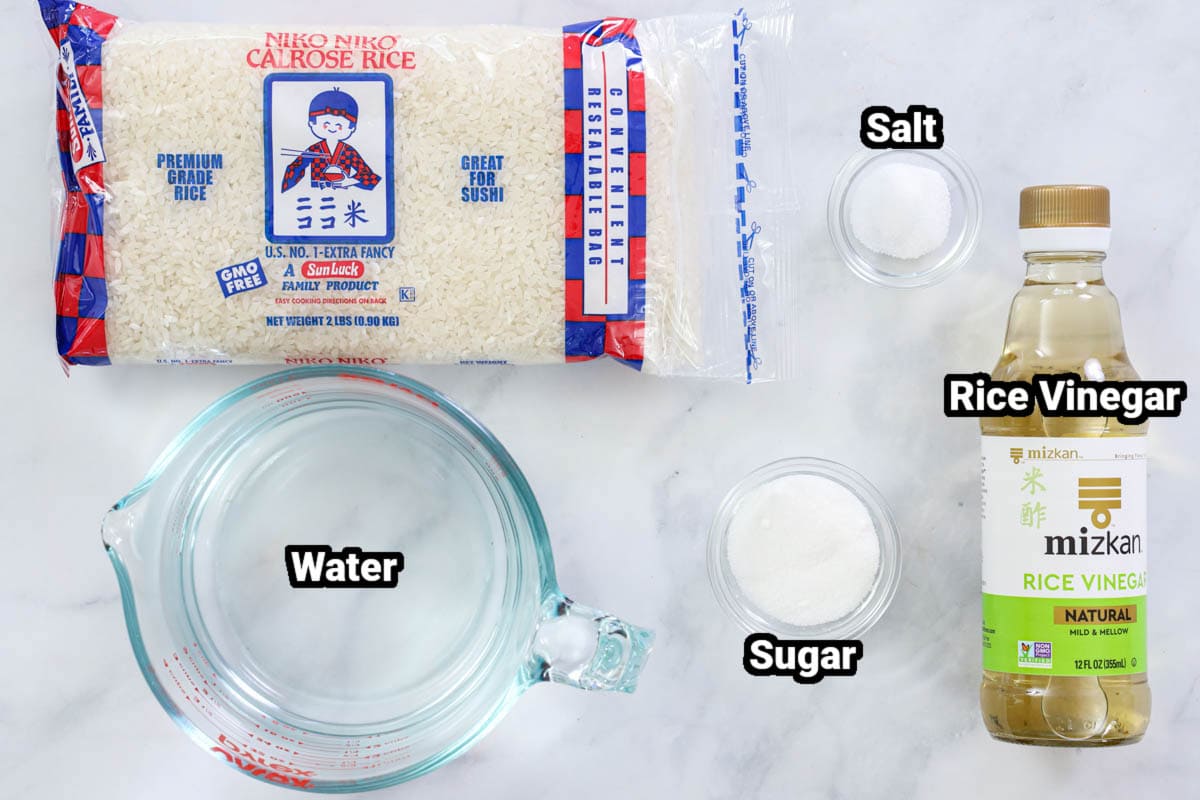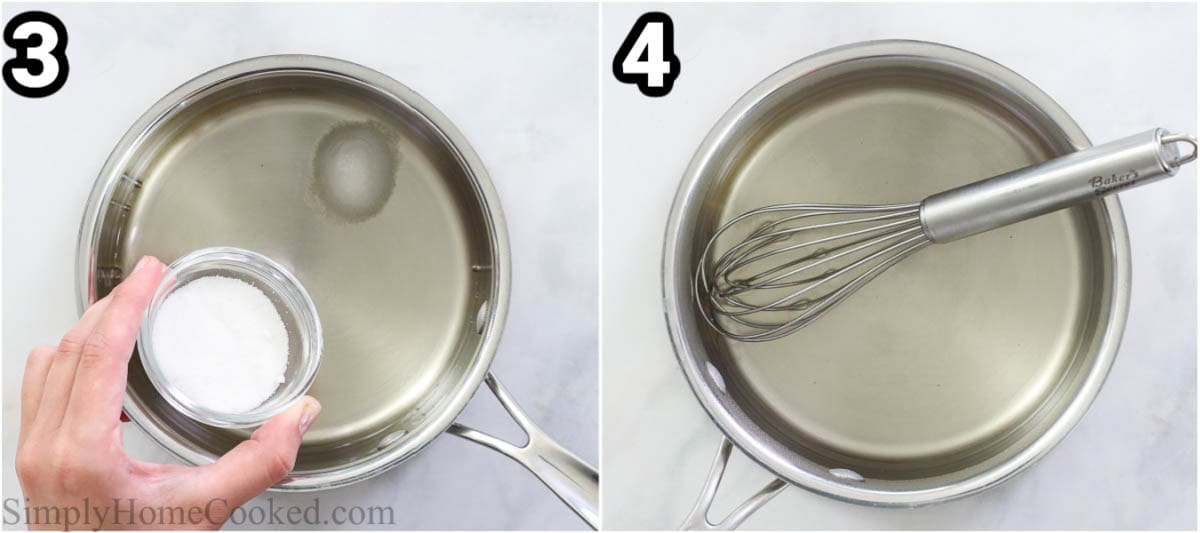If you love sushi, then you have to try this Sushi Rice Recipe. Tangy, sweet, and deliciously sticky, you can make your own rolls or just enjoy it as a side dish.
Try this recipe with other Asian-inspired dishes, such as these delicious California Roll Sushi Bowls and this Easy Sushi Bake.

Table Of Contents
Recipe Details
I love the rice in sushi rolls and bowls, so I just had to make some myself. This recipe is delicious and versatile, and you can enjoy it in so many ways.
- TASTE: Sweet and tangy, this Sushi Rice recipe has just a pinch of salt to balance out the natural sweetness of the rice and the granulated sugar.
- TEXTURE: This rice is very starchy and sticky, making it ideal for making your own homemade sushi rolls.
- TIME: This recipe takes about 30 minutes, but most of that is the rice cooking and then cooling at the end.
- EASE: This is a super simple dish that is made even simpler when you use a rice cooker. But even without, this sushi rice recipe is nice and easy, even for beginners.
What You’ll Need

Ingredient Notes
- Japanese rice- This is a short-grain white rice that is very starchy. This helps it become sticky enough to roll into sushi. The shorter the grain, the better.
- Rice vinegar- This ingredient is a mix of tangy and sweet, and adds delicious flavor to the rice.
- Sugar- Some granulated sugar boosts the natural sweetness of the rice, balancing out the salty, umami flavors that are usually added in sushi rolls.
- Salt- Just a little to complement the sweetness in the Sushi Rice.
- Water- To cook and hydrate the rice.
- Rice cooker- While you can cook rice on the stovetop or in the microwave, a rice cooker is the easiest way to do it. Just press a button and it will turn off and set to warm when it’s done.
Add-ins and Substitutions
- Substitute the rice vinegar- In place of it, you can use white wine vinegar, apple cider vinegar, lemon or lime juice, or champagne vinegar.
- Use a different rice- If you have no short-grain rice, you can also use medium-grain, such as arborio. Long-grain rice, like basmati, is possible, but it will be a lot less sticky because it lacks as much starch as the short.
- Substitute the sugar- If you prefer to avoid white sugar, you can use coconut sugar or honey to sweeten your sushi rice instead.
- Add Kombu- This dried sea kelp has lots of umami flavor and can add a briny, mushroom-like flavor to your sushi rice.
How to Make Sushi Rice
- Rinse the rice. Rinse the short-grain rice with cold water a few times until the water runs almost clear.
- Cook it. Place the rinsed and drained rice into your rice cooker, then add the water and turn it on to cook.
Pro Tip: I find the best way to rinse the rice is to place the rice in a fine-mesh sieve and run the kitchen faucet right through it.

- Make the sushi vinegar. Place the rice vinegar, sugar, and sea salt in a small saucepan and mix with a whisk. Boil and then bring it to a simmer. When the sugar dissolves, turn off the heat and let it cool.

- Combine the sushi vinegar and rice. When the rice is done cooking, immediately transfer it to a baking sheet and pour the sushi vinegar over it. Gently mix the vinegar into the rice, slicing and lifting it with your spoon or paddle.
- Allow to cool. Once everything is mixed, let it cool to room temperature before making sushi.

Recipe Tips
- Wash your rice- Doing this will remove a little bit of excess starch as well as any unwanted contaminants from the growing process.
- Use a paddle- A spoon can work, too, but a paddle is perfect for sifting the rice as it rinses, as well as fluffing it once it has been mixed with the vinegar mixture.
- Fluff the rice- You’ll want to make sure to use a slicing and lifting motion rather than a fold and smooth motion so the sushi rice can remain fluffy as it cools and becomes stickier.
- Let the rice cool before making sushi- If you are making sushi rolls with your rice, allow it to cool before starting. This lets the stickiness reach its max for better sushi-making.
FAQs
Sushi rice is made with short-grain rice that has a high level of starch. This makes it very sticky so you can roll it into sushi rolls. While you can make regular, longer-grain rice stickier and mushier with more water, the flavor and texture will not be exactly the same.
Mirin is a Japanese cooking wine with some alcohol content from the fermentation process. Rice vinegar, on the other hand, does not. The flavors are similar enough that you could add mirin to your sushi rice, but you might want to include some vinegar as it lacks the same level of tangy acidity found in rice vinegar.

Serving Suggestions
This Sushi Rice Recipe is perfect for snacking with seaweed, wrapping in sushi rolls, or adding to a bowl. It’s also versatile enough to be served with plenty of other dishes, too.
- Meats: Serve this sticky rice with some sliced Ribeye Steak, Grilled Teriyaki Chicken, Chicken Tempura, or Juicy Air Fryer Pork Chops (VIDEO).
- Seafood: Enjoy this Sushi rice recipe with Panko Crusted Salmon, Crispy Shrimp Tempura, Grilled Teriyaki Salmon, or Crab Salad (VIDEO).
- Sides: Start your meal with some Shrimp Tempura Udon Soup, Kani Salad, or She Crab Soup.
- Dessert: And end it with The BEST Mochi Donuts (VIDEO), this Easy Dango Recipe, or Strawberry Tanghulu.
Make This Recipe in Advance
Make ahead: You can prepare the sushi vinegar ahead of time, but the rice should be cooked only when you are ready to fully make this sushi rice recipe. As the rice sits, it gets gummy, making it harder to mix and less sticky for your sushi.
Storing: Store any leftovers from this Sushi Rice Recipe in an airtight container with a wet towel around it. It can stay at room temperature for up to 6 hours, or in the fridge for up to 5 days if wrapped well with a wet towel and plastic wrap to keep out the dry air.
Freeze: While you can store this rice in an airtight container and freeze for up to 3 months, it can defrost dry and crumbly. So it’s best eaten the day you make it or soon after.
More Yummy Asian Dishes!
Full Recipe Instructions

Sushi Rice Recipe
Equipment
Ingredients
- 3 cups Japanese short-grain rice
- 3 cups water
- 1/2 cup unseasoned rice vinegar
- 3 Tbsp granulated sugar
- 1 teaspoon fine sea salt
Instructions
- Rinse 3 cups of short-grain rice with cold water a few times until the water runs almost clear. I find it best to place the rice in a fine-mesh sieve and run the kitchen faucet right through it.
- Place the rinsed and drained rice into your rice cooker, then add 3 cups of water and turn it on to cook.
- In the meantime, make the sushi vinegar by placing 1/2 cup unseasoned rice vinegar, 3 Tbsp granulated sugar, and 1 teaspoon fine sea salt.
- Let it come to a simmer and mix using a whisk. Once the sugar dissolves, turn it off and let it cool.
- When the rice is done cooking, immediately transfer it to a baking sheet and pour the sushi vinegar over it. Use a paddle-style spoon or spatula to gently mix the vinegar into the rice. You’ll want to make sure to use a slicing and lifting lotion rather than a fold and smooth motion.
- Once the rice is mixed with the sushi vinegar, let it cool to room temperature before making sushi.
Notes
- Wash your rice- Doing this will remove a little bit of excess starch as well as any unwanted contaminants from the growing process.
- Use a paddle- A spoon can work, too, but a paddle is perfect for sifting the rice as it rinses, as well as fluffing it once it has been mixed with the vinegar mixture.
- Fluff the rice- You’ll want to make sure to use a slicing and lifting motion rather than a fold and smooth motion so the sushi rice can remain fluffy as it cools and becomes stickier.
- Let the rice cool before making sushi- If you are making sushi rolls with your rice, allow it to cool before starting. This lets the stickiness reach its max for better sushi-making.
Nutrition
- Kompot (Fruit Drink) - July 24, 2024
- Almond Flour Pancakes (gluten-free) - July 20, 2024
- Zeppole Recipe – Italian Donuts - July 18, 2024






Walter says
Can I make sushi rice with brown rice?
Dina says
Hi Walter, I have not made this recipe with brown rice yet. I think you will need to cook it a little longer.